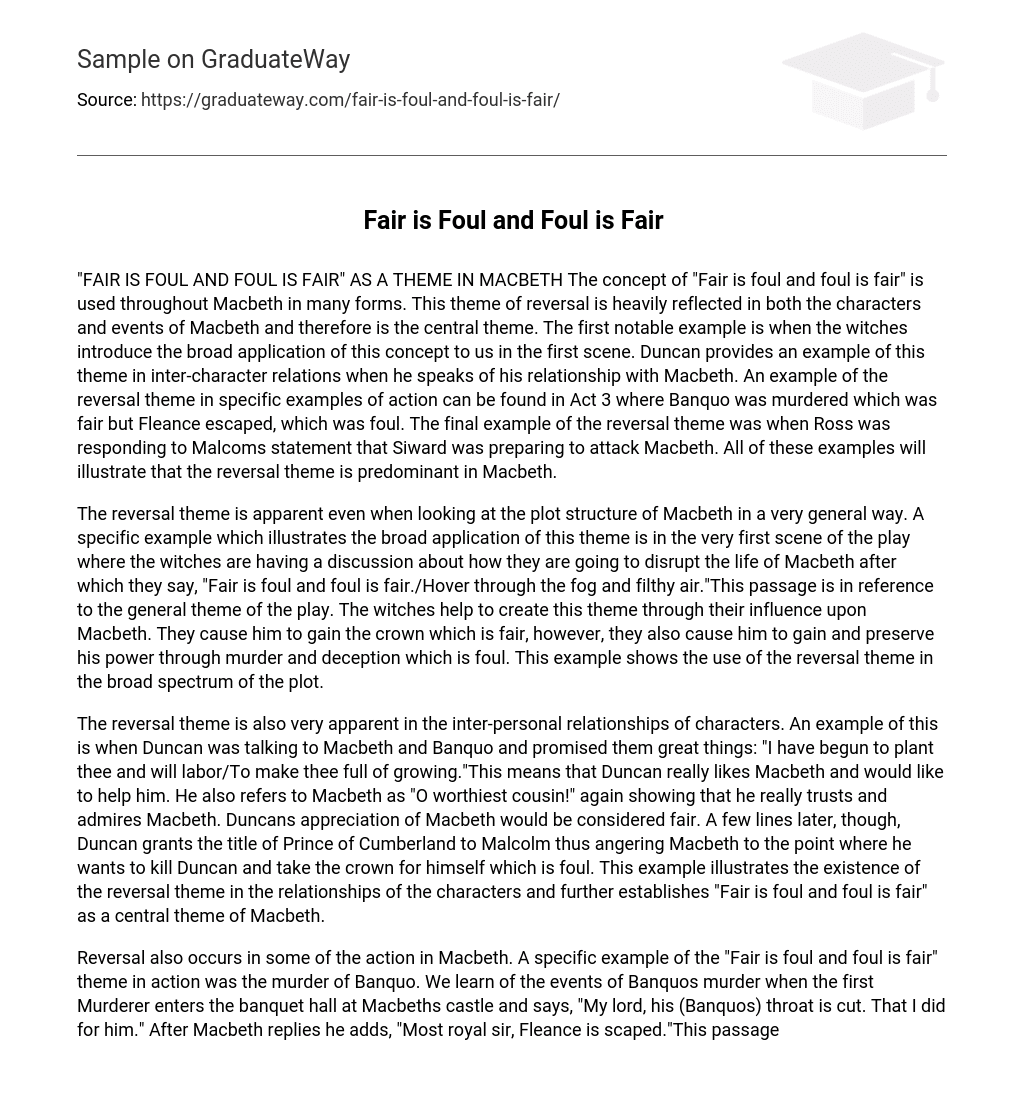The motif of “Fair is foul and foul is fair” is prevalent throughout Macbeth and is the central theme. This theme of reversal is evident in both the characters and events of the play. The witches introduce this concept in the first scene, establishing its broad application. Duncan exemplifies this theme in his relationship with Macbeth. Act 3 provides a distinct example of reversal, with Banquo’s murder being deemed fair, while Fleance’s escape is considered foul. Additionally, Ross’s response to Malcolm’s statement about Siward’s preparation to attack Macbeth further reinforces the theme of reversal. Together, these examples highlight the predominant presence of the reversal theme in Macbeth.
The theme of reversal is evident in the overall plot structure of Macbeth. An example that demonstrates the wide application of this theme is found in the very first scene of the play, where the witches discuss their plan to disrupt Macbeth’s life. They declare, “Fair is foul and foul is fair. / Hover through the fog and filthy air.” This passage references the play’s general theme. The witches contribute to this theme by influencing Macbeth. They help him acquire the crown, which is considered fair, but they also guide him towards gaining and preserving power through murder and deception, which is deemed foul. This example showcases the use of the reversal theme throughout the entire plot.
The theme of reversal is also evident in the interpersonal relationships of the characters. For instance, when Duncan spoke to Macbeth and Banquo, he made great promises to them: “I have begun to plant thee and will labor/To make thee full of growing.” This indicates that Duncan truly favors Macbeth and wants to assist him. Furthermore, Duncan refers to Macbeth as “O worthiest cousin!” reaffirming his trust and admiration for him. Duncan’s admiration of Macbeth can be considered fair. However, just a few lines later, Duncan grants the title of Prince of Cumberland to Malcolm, which greatly angers Macbeth and prompts him to contemplate killing Duncan and seizing the crown for himself, an act that is considered foul. This example highlights the presence of the reversal theme in the characters’ relationships and further establishes “Fair is foul and foul is fair” as a central theme in Macbeth.
Reversal is also evident in some of the action in Macbeth. The murder of Banquo serves as a specific example of the theme “Fair is foul and foul is fair” in action. The details of Banquo’s murder are revealed when the first Murderer enters Macbeth’s castle banquet hall and informs him, “My lord, his (Banquo’s) throat is cut. That I did for him.” Macbeth acknowledges this by saying, “Most royal sir, Fleance is scaped.” This passage indicates that Banquo has been murdered, but Fleance managed to escape from the killers. As Macbeth is the protagonist in this play, we perceive Banquo’s murder as fair even though he was innocent. On the other hand, we view Fleance’s escape as foul because it implies he has the potential to gain the crown. This exemplifies how the reversal theme manifests itself in the characters’ actions.
An example of the reversal theme within someone’s character is illustrated in Act 4 Scene 3, when Macduff converses with Malcolm. Malcolm confesses that he embodies all the negative qualities of vice, suggesting that even the notorious Macbeth would seem innocent compared to him. Consequently, Malcolm appears as a dishonorable figure lacking morals or values. This portrayal makes him an unsuitable candidate for the throne. However, Malcolm contradicts himself and asserts that he is actually virtuous and righteous. He claims to have remained unknown to woman, never broken a promise, rarely desired what belonged to others, remained faithful, refused to betray even the devil, and finds joy both in truth and life.
Old Siward was preparing to set forth with his ten-thousand war-like men to attack Macbeth’s fortifications at Dunsinane. Macduff was bewildered by the contradictory news he had received, remarking on the difficulty of reconciling such welcoming and unwelcoming things. This exemplifies the theme of “Fair is foul and foul is fair” within a character’s own mind, which is a central theme in Macbeth. The reversal theme, which explores reversals in characters’ fortunes causing confusion, is present throughout the play, such as in Macbeth’s rise to power and eventual downfall. This theme also extends to inter-character relationships, as seen in King Duncan’s opinion of Macbeth. Actions like Fleance’s escape after Banquo’s murder demonstrate the establishment of the “fair is foul and foul is fair” theme. Character revelation, like Macduff’s confusion after speaking with Malcolm, also reflects the reversal theme. Shakespeare’s understanding of human character allowed him to depict humanity’s tendency to perceive things one way when they are actually the opposite, giving us insight into our greatest flaws.
BIBLIOGRAPHY
Shakespeare, William. Macbeth, New York, NY: Bantam Books, 1988.
BIBLIOGRAPHYShakespeare, William. Macbeth, New York, NY: Bantam Books, 1996.
BIBLIOGRAPHYShakespeare, William. Macbeth, New York, NY: Bantam Books, 1996.





